Serviços Personalizados
Journal
Artigo
Indicadores
-
 Citado por SciELO
Citado por SciELO -
 Acessos
Acessos
Links relacionados
-
 Citado por Google
Citado por Google -
 Similares em
SciELO
Similares em
SciELO -
 Similares em Google
Similares em Google
Compartilhar
Earth Sciences Research Journal
versão impressa ISSN 1794-6190
Earth Sci. Res. J. v.9 n.2 Bogotá jul./dez. 2005
USING THE KARHUNEN-LOÈVE TRANSFORM TO SUPPRESS GROUND ROLL IN SEISMIC DATA
Ernesto Gómez Londoño1, Luís Castillo López2 and Thaís de Souza Kazmierczak2
1 Ingeominas Bogotá, Recursos del Subsuelo, e-mail: egomez@ingeominas.gov.co
2 Universidade Federal do Rio Grande do Sul - Brazil.e-mail: luis.castillo@ufrgs.br; e-mail: thais.kazmierczak@ufrgs.br
RESUMEN
En este estudio se implementó y modificó el Algoritmo de Sacchi (2002), basado en la Transformada Karhunen-Loève (K-L), como una técnica para la supresión de Ground Roll, mostrando que aunque la amplitud del Ground Roll es mayor que la amplitud de la señal al usar la Transformada K-L se tiene éxito en suprimirlo sin causar distorsión en las señales de reflexión, obteniendo mejores resultados frente a técnicas convencionales de remoción: f-k, Paso Alto y Pasa Banda. La Transformada K-L ha sido utilizada en el campo de la detección y procesamiento de imágenes (Levy and Linderbaurn, 2000), en el reconocimiento de caras, iris y huellas dactilares como factores biométricos de identidad. Una sección sísmica es una imagen del subsuelo por tanto esta transformada puede ser usada en el procesamiento sísmico, porque remueve partes correlacionadas espacialmente y proveyendo una imagen clara y coherente.El algoritmo se aplicó a registros generados con Martillo, Thumper y fuentes explosivas. Se hizo un procesamiento convencional hasta el apilado, remplazando los filtros por le uso de la transformada K-L. Los resultados muestran que la Transformada K-L hace una mejor recuperación de la amplitud de los reflectores, eliminando refracciones que causan eventos someros irreales e incrementando la coherencia lateral de los eventos sísmicos, facilitando la interpretación geológica.
Palabras clave: Amplitud, coherencia, filtro, Onda de Tierra, ruido.
ABSTRACT
The Sacchi’s algorithm (2002) based on the Karhunen-Loève (K-L) Transform was modified and implemented to suppress Ground Roll without distortion of the reflection signals, it provided better results than conventional techniques for noise removal like f-k, High-Pass and Band Pass Filters. The K-L Transform is well known in other fields as image processing (Levy and Linderbaurn, 2000), face, iris and fingerprint identification. A seismic section is an image of subsurface where the K-L can be useful in seismic processing because spatially uncorrelated signals can be removed providing a clear and coherent image. The algorithm was applied to seismic data generated with hammer, thumper and explosive sources. Conventional processing flows were used, but one replaced filters with K-L Transform, providing stacked sections. The K-L Transform recovers better the reflector amplitudes when compared with others filters, also it removes refractions that cause unreal shallow events and increases the lateral coherence of seismic events showing a more interpretable geology.
Key words: Amplitude, coherent, filter, Ground Roll, noise.
INTRODUCTION
The Ground Roll is (Scales and Snider, 1998) generated in shallow layers and is a typical Rayleigh wave. It is characterized by low velocity and frequency and high amplitude, being considered a coherent noise in seismic exploration (D'Agosto et al., 2002). The KL algorithm transforms the seismic data in a reasonable number of independent eigen functions that represents the most important signal characteristics. It has been considered a very advisable tool in the processing and analysis of reflection data (Al-Yahya, 1991).The conventional filtering techniques: f-k, High-Pass and BandPass are applied in the frequency domain but in the case of Ground Roll amplitude stronger than reflection signals, f-k filters cause serious distortion of the signal (Karsh and Bayrak, 2004). High Pass filter is based on the low frequency of the Ground Roll, with the disadvantage that also eliminates the low-frequency content of reflection signals. Band pass filter depends on the amount of overlaps between the noise and the signal, therefore when the frequency bands concentrated the energy in each band without overlap, the signal/noise ratio will not change (Yilmaz, 1987).The K-L Transform separates the Ground roll from the reflector signal, permitting to subtract it from seismic data. Its application to real data showed that the Ground Roll suppression increased lateral coherence of seismic events in a stacked section.
THEORETICAL BACKGROUND
The surface waves in the raw register in figure 1 travel with velocities ranging from 100 to 1000 m/s and with frequencies around 10 Hertz and lower than those of reflections and refractions. Note how the near surface effects distort travel time curve at the right flank of reflection "A".
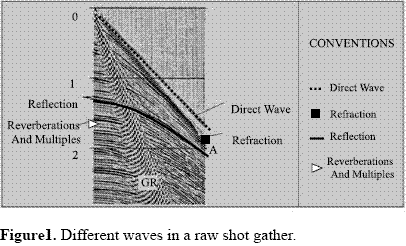
The Karhunen-Loève Transform
It makes a principal component analysis that is a mathematical way of determining that linear transformation of a sample of points in L-dimensional space which exhibits the properties of the sample most clearly along the coordinate axes. Along the new axes, the sample variance are extremes and uncorrelated, see figure 2. Using a cutoff on the spread along each axis, a sample may be reduced in its dimensionality. This way it can be used to transform independent coordinates into significant and independent ones.

K-L Transform Implementation
The seismic traces xi(t) correspond to the rows of the named data matrix xn*m , n is the number of traces in the gather and m the number of gathers. The zero-lag covariance matrix is (Jones and Levy, 1987):

This expression can be decomposed as

In equation 2 the columns of the matrix Vn*p are the eigenvectors and An*n is a diagonal matrix with the eigen values on the diagonal. These eigen values are ordered in descending sequence along the principal diagonal of the matrix An*n , Vt*np is the corresponding transpose matrix. The principal component of the data can be written by:

If we form the matrix M’p*m by selecting the upper m rows of the matrix Mp*m, m is related with the order of the filter or principal row number, placing zeros in the remaining n-m rows, n is related with the Cut of the Filter, the Ground roll is assumed to be represented by the matrix product between the eigenvectors matrix Vn*p and the matrix M’p*m, that include the principal components in agreement with the following expression:

Finally, the Ground roll X’n*m is subtracted from the data matrix Xn*m, obtaining the gather without Ground roll

Xo is a n*m matrix that represents the filtered seismic gather.As mentioned before xn*m is the input data matrix and X’n*m is a matrix that represents the Ground roll extracted from the input data.
RESULTS
The capacity of KL Algorithm to suppress Ground Roll at gather level is evaluated using shot gathers with dispersive waves of high amplitude, obtained from shallow and dip seismic surveys using 3 types of source were used: hammer, dynamite and thumper.
Hammer
The 102.data seismic gather (figure 3) is a record corresponding to the UN-01 Seismic Line. Note in the red square like the Ground Roll diminishes before (left) and after (right) KL Algorithm application; the gather is much less noisy in the first 100 ms, with Order of the Filter: 2 and Cut of the Filter: 1.Figure 4 shows the interactive spectral analysis for Seismic Record No 12 of UN-01, before on top and after on bottom the application of the K-L Transform. The K-L Filtering gives good results because it compresses more the amplitude spectrum. Additionally, the maximum amplitude of the raw power spectrum with the K-L is lower into the red circle (10000) compared with one of the same gather without this filter in the black circle (4,5 e + 07), indicating high amplitude concentrations in the spectrum; corresponding to the Ground Roll suppressed with K-L. The record with K-L displays seismic events with coherence and continuity.

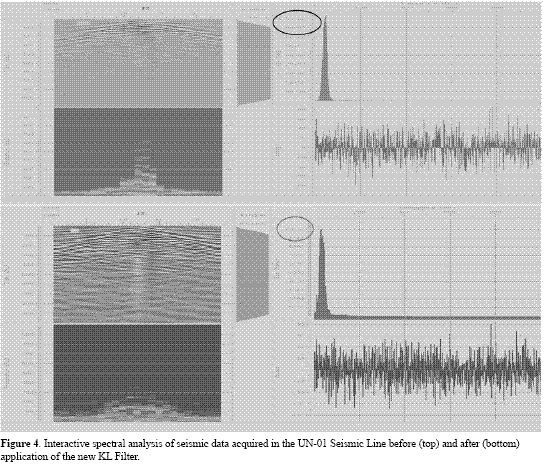
Explosive Source
The shot gather in Figure 5, was generated using dynamite, it displays hyperbolic moveout, coherent noise masking the reflection signals. The analyses with f-k, High-Pass and the KL Filters gave the better results for the last one.The Band-Pass filter is used where the seismic trace contains low-frequency noise, such as Ground Roll and high-frequency ambient noise. The seismic reflection energy usually is confined to a bandwidth between 10 to 70 Hertz, with dominant frequency of 15 Hz.Comparison between Band-Pass [15-30-55-70] (Figure 6), and KL Filter gave a better result for the KL, the Ground Roll cone has been suppressed and the lateral coherence of deeper seismic events increased.
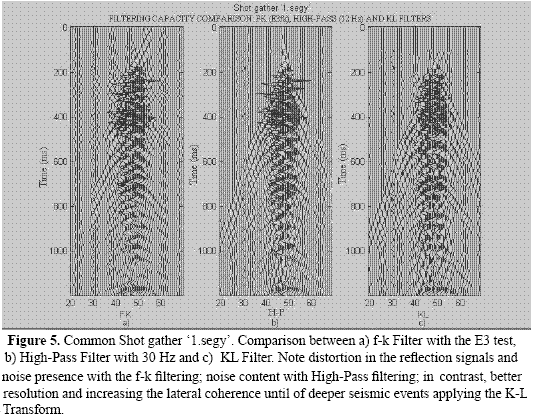

Thumper
Figure 7 shows an example, of the shot gather 481 with high content of Ground Roll. The Seismic Line RM-01, was acquired using a thumper source. A substantial increasing in the lateral coherence of the seismic events below the 200 ms is remarked.Figure 8 shows the amplitude spectrum of the shot gather 481 before and after the KL filter application, a significant reduction of the high amplitude corresponding to Ground Roll is seen.
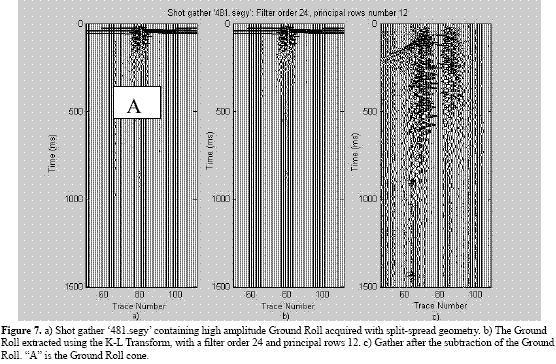

Shallow Survey
The 2D seismic data was acquired in October-2004 with a split spread configuration in the campus of the National University of Colombia, with a Geode seismic recorder with 24 channels for high resolution acquisition, the source consist in a hammer (8 kg) and geophones with vertical component. The processing of the UN-01 Seismic Line provided stacked sections shown in Figure 9, on top conventional and on bottom with K-L. The section on bottom presents better results, increases lateral coherence and gives a clearer image. On the other hand, the KL suppresses unreal shallow events (indicated by the arrow), due to refractions that are observed with the conventional processing.
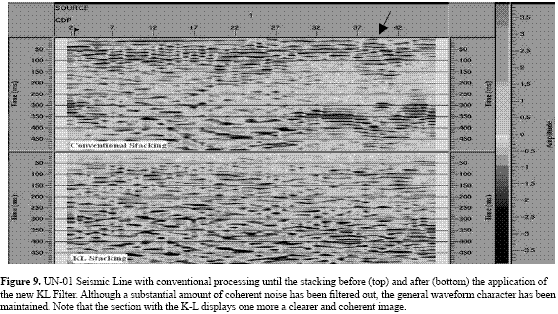
Deep Survey
This 2D data was acquired using a thumper in split spread configuration at Southern of the Middle Magdalena Valley, involving tertiary sediments from the Gualanday Group.The stacked section in RM-01 in Figure 10 was obtained with conventional processing on bottom and with application of the K-L Transform on top. The top image presents a great rank of amplitude (-3 to 3) compared with the conventional stacked on bottom (-2 to 2) as observed into the red circles; indicating a better amplitude recovering in reflectors with K-L use, although the processing sequence did not include fx Decon. Besides the KL shows coherence and it does not present the whitening effect due to the conventional processing flow (Figure 10. Red square, bottom). By the other hand, high dips (black arrow), are observed in conventional process image which are not true because the direction of seismic line was N-S, parallels to the beds strikes of the tertiary sediments with very smooth dips; in consequence they must be horizontals in the seismic section, as it is observed in the K-L image in agreement with the subsurface geology.

CONCLUSIONS
The Algorithm Karhunen-Loève is computationally economic and efficient to filter seismic data, providing coherent information of subsurface image.The interactive spectral analysis showed more concentrations of high amplitude due to the Ground Roll, and it verifies that K-L Algorithm suppresses the Ground Roll waves. Also it is verified than the amplitude of the Ground Roll is stronger than the reflection signals. By using K-L Algorithm to extract the Ground Roll it suggests a form to suppress Ground Roll, without distorting the reflection signals.Additionally, using K-L filter increases the lateral coherence of seismic events, in comparison with the three conventional methods of suppression: Filters f - k, High-Pass and Band- Pass. The algorithm was tested with raw gather containing Ground Roll (high amplitude) obtained from shallow and depth seismic land surveys with different source (hammer, dynamite and thumper. A lateral coherence increase is observed in stacked sections. The K-L use recovers the amplitude of the deep reflectors furnishing a resultant section more approximated to real geology.
REFERENCES
• Al-Husseini, M., Glover J. and Barley B., 1981. Dispersion Patterns of the Ground Roll in Eastern Saudi Arabia, Geophysics, Vol 46, p. 121-137. [ Links ]
• Al-Yahya, K.M., 1991. Application of the Partial Karhunen-Loève Transform to Suppress Random Noise in Seismic Sections: Geophys. Prosp., 39, p. 77-93. [ Links ]
• DAgosto, C., Marfurt, K. and Steven, J., 2002. Modeling and Removal of Ground Roll from Horizontal Component of C-Waves. SEG. [ Links ]
• Jones, I. F., and Levy, S., 1987. Signal - to - Noise Enhancement in Multichannel Seismic Data Processing: Geophys. Prosp., 35, p. 12-32. [ Links ]
• Karsh, H. and Bayrak, Y., 2004. Using the Wiener - Levinson Algorithm to Suppress Ground Roll. Journal of Applied Geophysics 55, p 187-197. [ Links ]
• Levy, A. and Linderbaurn, M., 2000. Sequential Karhunen-Loève Basis Extraction and its Application to Images, IEEE Transactions on Image Processing, Vol 9, No 8, p. 1371-1374. [ Links ]
• Nesvijski, E. G., 2000. On a Possibility of Rayleigh Transformed Sub-Surface Waves Propagation. Center of Technology, Federal University of Santa Maria, Brasil. [ Links ]
• Sacchi, M.D., 2002. Karhunen - Loève (KL) Filtering of Seismic Data Algorithm. Signal Analysis and Imaging Group (SAIG), Department of Physics, Alberta University. [ Links ]
• Scales, J. and Snider, R., 1998. ¿What is Noise?: Geophysics, Vol 63, p. 1122-1124. [ Links ]
• Yilmaz, O., 1987. Seismic Data Processing: Society of Exploration Geophysicists, Tulsa, p. 9-79. [ Links ]
• Zywicki, D., 1999. Traditional Seismic Surface Wave Tests. Georgia Tech Research Institute (GTRI), p. 11.34. [ Links ]














